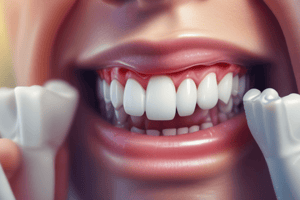Podcast
Questions and Answers
Why is ART considered a conservative approach?
Why is ART considered a conservative approach?
- It causes pulp irritation and patient discomfort
- It removes decayed tissue with hand instruments, preserving as much tooth structure as possible (correct)
- It requires the removal of more tooth structure than necessary
- It avoids the use of hand instruments for cavity preparation
What is the main characteristic of Atraumatic Restorative Treatment (ART)?
What is the main characteristic of Atraumatic Restorative Treatment (ART)?
- It requires the use of rotary dental instruments
- It can only be performed in settings with access to dental equipment
- It involves the use of local anaesthetic injections
- It removes decayed tissue using hand instruments (correct)
For which type of cavities can ART be used?
For which type of cavities can ART be used?
- For small, medium, and deep cavities caused by dental caries (correct)
- Only for shallow cavities
- For cavities requiring the use of local anaesthetic injections
- Only for deep cavities reaching the tooth nerve
What is the key consideration when removing decay in deeper cavities during ART?
What is the key consideration when removing decay in deeper cavities during ART?
Which dental instruments are used in Atraumatic Restorative Treatment (ART)?
Which dental instruments are used in Atraumatic Restorative Treatment (ART)?
What is the main factor that determines how much decay to remove during a cavity treatment?
What is the main factor that determines how much decay to remove during a cavity treatment?
What is the benefit of using Atraumatic Restorative Treatment (ART) for patients?
What is the benefit of using Atraumatic Restorative Treatment (ART) for patients?
Why were dental radiographs recommended when evaluating cavities?
Why were dental radiographs recommended when evaluating cavities?
Who introduced the Atraumatic Restorative Treatment (ART) in 1985?
Who introduced the Atraumatic Restorative Treatment (ART) in 1985?
What type of tooth decay is ART suitable for?
What type of tooth decay is ART suitable for?
What makes ART suitable for use in any type of setting according to the text?
What makes ART suitable for use in any type of setting according to the text?
Why was ART recommended during the International Caries Consensus Collaboration (ICCC) meeting in 2015?
Why was ART recommended during the International Caries Consensus Collaboration (ICCC) meeting in 2015?
According to the text, what is a benefit of ART for patients with dental anxiety or learning disabilities?
According to the text, what is a benefit of ART for patients with dental anxiety or learning disabilities?
What was the primary reason for developing ART, as mentioned in the text?
What was the primary reason for developing ART, as mentioned in the text?
Flashcards are hidden until you start studying
Study Notes
Atraumatic Restorative Treatment (ART)
- ART is considered a conservative approach.
Characteristics of ART
- The main characteristic of ART is to remove decay and restore cavities with minimal intervention.
Indications for ART
- ART can be used for cavities in enamel, dentin, and cavities extending into the pulp.
Removing Decay in Deeper Cavities
- The key consideration when removing decay in deeper cavities during ART is to avoid exposure of the pulp.
Instruments Used in ART
- Dental instruments used in ART include hand instruments, such as excavators and spoon excavators.
Determining Decay Removal
- The main factor that determines how much decay to remove during a cavity treatment is the depth and extent of the decay.
Benefits of ART
- The benefit of using ART for patients is that it reduces anxiety, pain, and stress.
- ART is suitable for patients with dental anxiety or learning disabilities due to its non-invasive and pain-free approach.
Evaluation of Cavities
- Dental radiographs were recommended when evaluating cavities to assess the extent of decay.
History of ART
- ART was introduced by Dr. Jo Frencken in 1985.
Suitability of ART
- ART is suitable for treating primary tooth decay.
- ART is suitable for use in any type of setting due to its simplicity, low cost, and minimal equipment requirements.
Recommendation of ART
- ART was recommended during the International Caries Consensus Collaboration (ICCC) meeting in 2015 due to its minimally invasive approach.
Primary Reason for Developing ART
- The primary reason for developing ART was to provide a simple, low-cost, and pain-free approach to treating cavities in developing countries.
Studying That Suits You
Use AI to generate personalized quizzes and flashcards to suit your learning preferences.




